Management of giant rat’s tail grass and other weedy Sporobolus grasses
 Giant rat’s tail grass (Sporobolus natalensis and S. pyramidalis) is part of the group of weedy Sporobolus grasses that also includes American rat’s tail grass (S. jacquemontii), Giant Parramatta grass (S. fertilis) and Parramatta grass (S. africanus). They are exotic (non-native) to Australia and characterised by their robust, tufted, well-rooted perennial tussocks, with tougher leaf blades than most other grasses.
Giant rat’s tail grass (Sporobolus natalensis and S. pyramidalis) is part of the group of weedy Sporobolus grasses that also includes American rat’s tail grass (S. jacquemontii), Giant Parramatta grass (S. fertilis) and Parramatta grass (S. africanus). They are exotic (non-native) to Australia and characterised by their robust, tufted, well-rooted perennial tussocks, with tougher leaf blades than most other grasses.
Weedy Sporobolus grasses aggressively colonise disturbed areas and overgrazed or weakened pastures. They can dramatically reduce pasture productivity, out-compete desirable pasture grasses and cause significant degradation of natural areas. Management of giant rat’s tail grass and other weedy Sporobolus grasses requires an integrated approach involving prevention and control activities and the incorporation of pasture, land and livestock management considerations.
On this page is more information about giant rat’s tail grass and other weedy Sporobolus grasses including:
- Best practice manual
- Producer case studies
- Webinar recordings
- Article: Ten things we can do to manage giant rat’s tail grass
- Project report: Gauging the effects of the fungus Nigrospora oryzae on giant rat’s tail grass
- Where to get more information.
Best practice manual
This manual provides practical information to help landholders manage weedy Sporobolus grasses. The manual takes a strategic approach to weed management. A variety of common weed ‘situations’ are examined, and a ‘best bet’ strategy presented for each. These ‘best bet’ strategies are based on the latest research, and focus on achieving effective weed control in a cost-efficient way. Weed management is tackled in an integrated way. Chemical control is combined with best practice land management techniques to effectively control current infestations and prevent the spread of weeds to ‘clean’ country.
View or download the best practice manual here (PDF 1MB).
Producer case studies
Four case studies were collated during property visits with paddock inspections and landholder interviews about their enterprise, the problem, management history, results and key lessons.
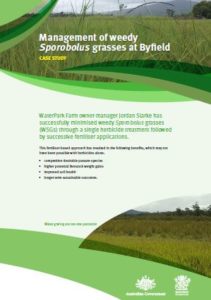 Management of weedy Sporobolus grasses at Byfield
Management of weedy Sporobolus grasses at Byfield
WaterPark Farm (Byfield north-east of Rockhampton) owner-manager Jordan Slarke has successfully minimised weedy Sporobolus grasses through a single herbicide treatment followed by successive fertiliser applications. This fertiliser-based approach has resulted in the following benefits, which may not have been possible with herbicides alone:
• competitive desirable pasture species
• higher potential livestock weight gains
• improved soil health
• longer term sustainable outcomes.
Read more about the Byfield case study here (PDF, 1 MB) .
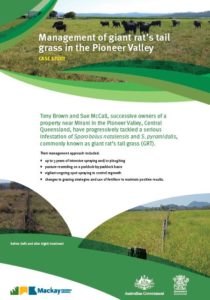 Management of giant rat’s tail grass in the Pioneer Valley
Management of giant rat’s tail grass in the Pioneer Valley
Tony Brown and Sue McCall, successive owners of a property near Mirani in the Pioneer Valley, Central Queensland, have progressively tackled a serious infestation of Sporobolus natalensis and S. pyramidalis, commonly known as giant rat’s tail grass. Their management approach included:
• up to 3 years of intensive spraying and/or ploughing
• pasture reseeding on a paddock-by-paddock basis
• vigilant ongoing spot-spraying to control regrowth
• changes to grazing strategies and use of fertiliser to maintain positive results.
Read more about the Pioneer Valley case study here (PDF, 1 MB).
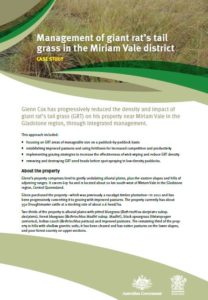 Management of giant rat’s tail grass in the Miriam Vale district
Management of giant rat’s tail grass in the Miriam Vale district
Glenn Cox has progressively reduced the density and impact of giant rat’s tail grass on his property near Miriam Vale in the Gladstone region, through integrated management.
This approach included:
• focusing on areas of manageable size on a paddock-by-paddock basis
• establishing improved pastures and using fertilisers for increased competition and productivity
• implementing grazing strategies to increase the effectiveness of wick-wiping and reduce giant rat’s tail grass density
• removing and destroying seed heads before spot-spraying in low-density paddocks.
Read more about the Miriam Vale case study here (PDF, 1 MB).
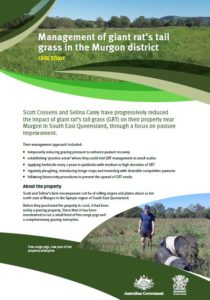 Management of giant rat’s tail grass in the Murgon district
Management of giant rat’s tail grass in the Murgon district
Scott Cossens and Selina Carey have progressively reduced the impact of giant rat’s tail grass on their property near Murgon in South East Queensland, through a focus on pasture improvement.
Their management approach included:
• temporarily reducing grazing pressure to enhance pasture recovery
• establishing ‘practice areas’ where they could trial giant rat’s tail grass management at small scales
• applying herbicide every 2 years in paddocks with medium to high densities of giant rat’s tail grass
• regularly ploughing, introducing forage crops and reseeding with desirable competitive pastures
• following biosecurity procedures to prevent the spread of seeds.
Read more about the Murgon case study here (PDF, 1.3 MB).
Webinar recordings
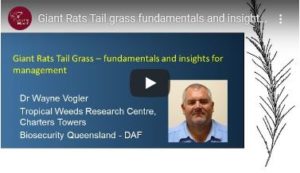 Giant rat’s tail fundamentals and insights for management
Giant rat’s tail fundamentals and insights for management
Presented by Dr Wayne Vogler (Biosecurity Queensland), published 29 March 2019
Understanding basic giant rat’s tail grass biology enables landholders to develop clear management strategies that will assist in reducing its impacts and maintaining productivity of grazing land. Relying solely on a single management tool such as herbicides will not achieve satisfactory outcomes.
In this webinar recording Dr Wayne Vogler discusses the requirements of an integrated management approach which includes all aspects of pasture management to maintain a productive pasture if the negative impacts of giant rat’s tail grass are to be kept to a minimum.
View the webinar recording here.
 Sporobolus management in Bahiagrass pastures in Florida
Sporobolus management in Bahiagrass pastures in Florida
Presented by Professor Brent Sellers (University of Florida), published 2 April 2018
Professor Brent Sellers was on a study tour to compare United States and Australian practices of weedy Sporobulus grass management on cattle production.
In this webinar recording Brent discusses the herbicide and pasture management programs used in Florida to reduce the impact of smutgrass. This is relevant to producers in Queensland and other parts of Australia where there are significant problems with Sporobulus grasses in sown and native pastures in Australia.
View the webinar recording here.
GRT Videos
Two GRT videos have been produced by the Gladstone Regional Council and the Queensland Department of Agriculture and Fisheries. Find them here: GRT seed spread management and GRT herbicides.
Article: Ten things we can do to manage giant rat’s tail grass
While there is still no silver bullet for giant rat’s tail grass, ten things we can do to manage it are:
-
- Get suspected grass positively identified.
- Control isolated plants and stop seeding.
- Contain the spread.
- Apply the correct calibrated dose of flupropanate for effective control.
- When spot spraying with glyphosate be careful not to damage nearby beneficial, competitive pasture grass.
- Abide by grazing withholding periods when applying herbicides.
- Budget for ongoing follow up for many years.
- Quarantine cattle for seven days to prevent the spread of seed into clean areas.
- Promote pasture competition to aid control.
- For cost effectiveness consider the option of cultivating and forage cropping.
Adapted from Marie Vitelli’s article in the September 2017 edition of AgForce’s ENVOY magazine.
Project report: Gauging the effects of the fungus Nigrospora oryzae on giant rat’s tail grass
This project investigated the effects of the fungus Nigrospora oryzae on giant rat’s tail grass in the Mackay Whitsunday region and made an assessment of its role as a potential form of biological control. The project was conducted between November 2012 and October 2015. For more information, please download and read the final report (PDF 2 MB).
Where to get more information
Download a copy of the Queensland Herbariums step-by-step guide to collecting, preserving and submitting plant specimens for identification at the Business Queensland How to identify specimens web page.
The rat’s tail grasses: Sporobolus pyramidalis, S. natalensis, S. jacquemontii and S. fertilis fact sheet (PDF, 9.27 MB) (by Biosecurity Queensland) summarises the legal requirements, description, distribution, control and management strategies for weedy Sporobolus grasses in Queensland.
The aim of the Reducing weed risks from fodder (PDF, 10.2 MB) guide (by the Queensland Herbarium) is to increase awareness of weed risks associated with fodder use in Queensland. It highlights tools and strategies to help assess weed risks when sourcing fodder and how to reduce week risk when transporting, storing and feeding out fodder.
More general and related information about giant rat’s tail grass is available from Business Queensland and NSW WeedWise.
The Weed Spotters’ Network Queensland aims to find, identify and document new occurrences of potential weeds to allow prevention and early intervention. It manages a community-based weed alert system, produces a monthly weed spotters’ bulletin and has resources to help with weed identification.
Further information is available from your local government office, or by contacting Biosecurity Queensland on 13 25 23 or visit www.biosecurity.qld.gov.au.